Wagler’s Pit Viper
Wagler’s Pit Viper (Tropidolaemus wagleri)
Tropidolaemus wagleri – also called: Wagler’s Pit viper; temple viper; bamboo snake; speckled pit viper
[Last Updated: 14 July 2023]
Thais say: ngoo keow took geh
Length: Average length of 60 cm. Males are smaller than female. Female maximum length at 100 cm.
Appearance: Wagler’s pit viper is a short green (งูเขียว) pit viper and the female is considerably thicker (3-4 times as thick) than the male. A marked difference in patterns is noted with the female becoming darker and with strong banding as you can see in the above image. The males are so radically different that they look like completely different species (sexual dimorphism). In three reptile identification books I have for Thailand, they make no mention of the differences between the sexes. The female is pictured in each case.
Dorsal scale count ( 23 to 29 ) – ( 21 to 27 ) – ( 17 to 21 ) and usually 21 to 23 mid-body dorsal scale rows in males and 23 to 27 mid-body scale rows in females. Dorsal scales are strongly keeled in females and lesser keeled in males.
Coloration can vary significantly among females. Here is a very yellow T. wagleri.
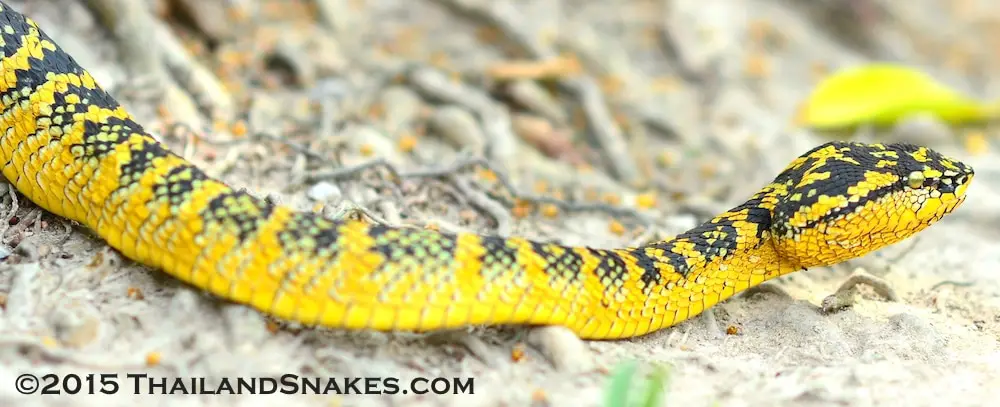
Here is a darker-colored female, but not nearly as much as the top and bottom photos on this page. Not nearly as much lateral yellow as in the previous photo.
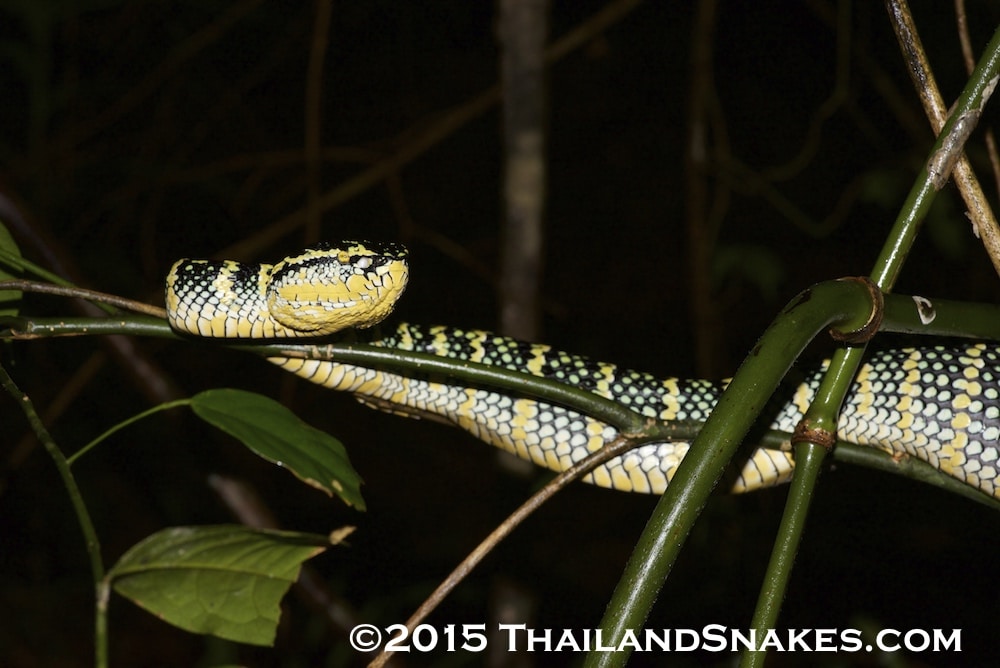
Besides the difference in size, thickness, and pattern, the body type is also quite different. The male grows to be around 60 cm and is long and thin, more like a wolf snake or something similar.
Below is a photo of a male Wagler’s pit viper found within one meter of a very gravid female. Obviously quite a big difference.
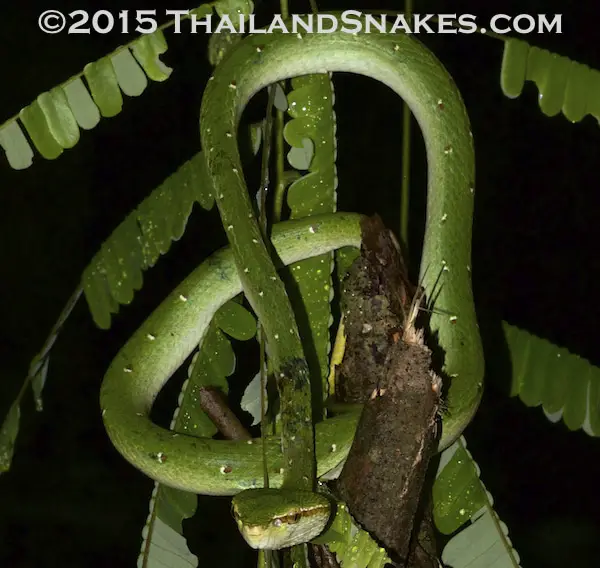
Range: Southern Thailand south of Khao Sok National Park, Suratthani province. Other countries: West Malaysia; Indonesia; Philippines. There is a concentration of these common vipers on the island of Phuket, Thailand.
Habitat: Elevations up to about 1,200 meters but most abundant at elevations from 400 up to about 600 meters in lowland primary forest, secondary forest, and jungle – especially coastal mangroves. During the day these vipers can sometimes be found as little as a meter off the ground, up to a couple of meters. They seem to prefer bushes over trees. Recently I found a gravid female one meter off the forest floor and resting on a strong vine just 1 cm in diameter.
Active Time? Mainly nocturnal, but occasionally found during the day, especially during or after rain. Crepuscular in nature, they are more often active during dusk and dawn, or on an unusually dark day during heavy rain. I have found these snakes during the day in moderate rain at 400 meters elevation, and at 2000 hours after a light rain.
Food: Birds – especially baby birds in the nest, mice and other rodents, lizards, frogs.
Defensive Behavior: Coil back into s-shape before striking. The strike is typically less than .3 meters in distance. Mouth wide open exposing very long fangs and white tissue. Can strike in succession rather quickly. Their strike is not very fast in comparison with some of the other vipers.
The heat-sensing pits between the eyes can sense temperature differences as little as 0.003 degrees Celsius. If continuously threatened they may hold their mouth wide open, like the photo above.
Venom Toxicity: Potentially deadly. Strong venom that usually does not result in death to humans. Victims experience a strong burning sensation upon envenomation and swelling, necrosis of tissue. The multi-valent antivenom for green pit vipers treats envenomation by this snake.
Antivenom Code: SAsTRC01
Antivenom Name: Green Pit Viper Antivenin
Manufacturer: Science Division, Thai Red Cross Society
Phone: +66-2-252-0161 (up to 0164)
Address: Queen Saovabha Memorial Institute, 1871 Rama IV Road, Pathumwan, Bangkok 10330
Country: Thailand
Offspring: Live birth in September is common, with up to 41 young per litter. Male and females look different from day one, the females having light banding and the males with creme / red or brown dots on the top of the body.
Notes: Though these snakes are said to be exclusively arboreal and nocturnal, I found one on a mountain recently during the middle of the day, on the ground, during a rain shower. See the video below.
Tropidolaemus wagleri
Classification
Kingdom: Animalia
Phylum: Chordata
Subphylum: Vertebrata
Class: Reptilia
Order: Squamata
Suborder: Serpentes
Family: Viperidae
Subfamily: Crotalinae
Genus: Tropidolaemus
Species: T. wagleri
Binomial name: Tropidolaemus wagleri
Classified by Boie, in the year 1827.
Top of head – very triangular, and thin neck (female):
Video 1 – Wagler’s Pit Viper – found during daylight hours during a moderate rain shower with dark skies at around 400 meters elevation on a mountain in Krabi province, Southern Thailand.


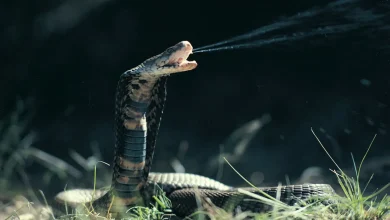
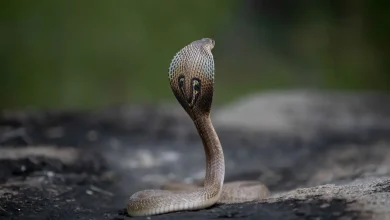
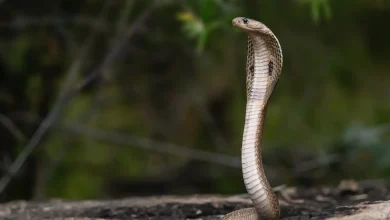
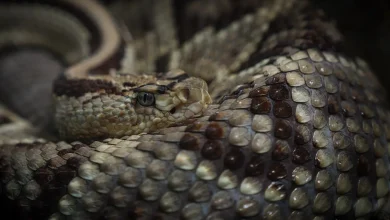
Could you share more information about the wagler pit viper’s shedding behavior?!
They will shed as any snake would, just that they will either come down on the ground to shed, or they would just shed on the trees by moving from branches to branches until the shed come off.
What is the suitable tempreature required to keep temple pit viper, in captivity?
Don’t know. I don’t keep snakes.
26-30 Celsius is acceptable.
It never ceases to amaze me how many people, unprofessional amateur collectors, make attempts, succeed in attempts to buy venomous snakes to keep in their residences for personal pleasures(?). That’s all I can imagine it is, personal pleasure, the self gratification of owning these or gratification of bragging to others.
As noted a boy was envenomated by a cobra in Texas recently (where if released in any numbers could become an invasive species).
I’m glad your page is out here educating people and warning them sharply about the dangers of these snakes, but concerned that I saw several requests with email contacts of people looking to purchase venomous snakes from SE Asia.
The US Customs and Borders Animal unit is so busy they are likely to miss something or misidentify something and I hope you’ll pull such requests down as soon as they show up or note in large print that this is not a page for animal trade, of any type, particularly venomous snakes.
Kind Regards
CC: US Customs and Border Control Animal Division